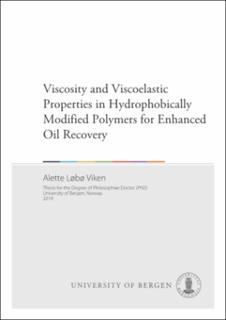| dc.contributor.author | Viken, Alette Løbø | |
| dc.date.accessioned | 2019-07-31T09:46:44Z | |
| dc.date.available | 2019-07-31T09:46:44Z | |
| dc.date.issued | 2019-01-25 | |
| dc.identifier.uri | https://hdl.handle.net/1956/20603 | |
| dc.description.abstract | Polymers have been studied and used for mobility control since the 1960s and found to improve the mobility ratio between the injected fluid and the displaced oil. However, small changes in polymer structure and/or relation between different physical aspects can change the polymers behavior and their viscosifying ability. The most used and studied polymer for EOR is hydrolysed polyacrylamide (HPAM). The viscosifying ability of HPAM is strongly dependent on temperature and brine salinity and is poor at HTHS (high temperature, high salinity) conditions. To address this problem, several modified polymers of HPAM, for instance hydrophobically modified HPAM have been introduced. Some have shown potential to withstand a loss of viscosity in high salinity brines and at high temperatures as the hydrophobic groups present are able to interact and create a network A number of factors within the structure of a polymer; such as molecular weight, type of backbone, degree of hydrolysis, type of hydrophobic groups, length and amount of hydrophobic groups etc, can influence the polymer properties. External parameters as salinity, pH, temperature and shear forces applied will also affect how the polymer behaves. In this thesis rheological behavior of two series of hydrophobically modified HPAM polymers, HMPAM, are studied and compared to their HPAM counterpart. The polymer series varies in degree of hydrophobicity, where the first series changes in amount of hydrophobic groups attached to the polymer backbone and the second changes in length of hydrophobic group. The study can be divided in three parts; influence of salinity, influence of temperature and differences in bulk viscosity and in-situ viscosity. The first paper reports a salinity study on the first polymer series where the hydrophobicity changes with increasing amount of hydrophobic groups. The rheological measurements showed that in order to increase the viscosity in the HMPAM polymers above HPAM, a threshold value of amount of hydrophobic groups needed to be crossed. This threshold value was lowered with increasing salinity. In the second paper, variation in both salinity and temperature was investigated for the polymer series with increasing length of the hydrophobic group. The main findings in this study showed that the polymer with the most viscosifying abilities at high salinity was outperformed by the less viscous polymer at high temperature, especially in both high salinity and high temperature. Even though a polymer might have good properties in bulk rheology measurements, the behavior and interactions in a porous media might be very different. Paper III compared an HMPAM polymer with its HPAM counterpart in both bulk rheology and in-situ rheology measurements. The polymers showed similar behavior and shear viscosities in bulk measurements. However, HMPAM experienced higher in-situ viscosity, which most likely is a result of induced hydrophobic interactions in the porous media due to spatial restrictions. | en_US |
| dc.language.iso | eng | eng |
| dc.publisher | The University of Bergen | en_US |
| dc.relation.haspart | Paper I: Viken, A. L., Skauge, T, Spildo, K, Rheological properties of a hydrophobically modified anionic polymer: Effect of varying salinity and amount of hydrophobic moieties. Journal of Applied Polymer Science, 2016. 133(23): p. 1-8. The article is available in the main thesis. The article is also available at: <a href="https://doi.org/10.1002/app.43520" target="blank">https://doi.org/10.1002/app.43520</a> | en_US |
| dc.relation.haspart | Paper II: Viken, A.L., Skauge, T., Svendsen, P., Time, P.A., Spildo, K., Thermothickening and Salinity Tolerant Hydrophobically Modified Polyacrylamides (HMPAMs) for Polymer Flooding, Energy & Fuels, 2018. 32(10) p. 10421-10427. Full text not available in BORA due to publisher restrictions. The article is available at: <a href="https://doi.org/10.1021/acs.energyfuels.8b02026" target="blank">https://doi.org/10.1021/acs.energyfuels.8b02026</a> | en_US |
| dc.relation.haspart | Paper III: Viken, A.L., Spildo, K., Reichenbach-Klinke, R., Djurhuus, K., Skauge, T., Influence of Weak Hydrophobic Interactions on in Situ Viscosity of a Hydrophobically Modified Water-Soluble Polymer, Energy & Fuels, 2018, 32, 89-98. Full text not available in BORA due to publisher restrictions. The article is available at: <a href="https://doi.org/10.1021/acs.energyfuels.7b02573" target="blank">https://doi.org/10.1021/acs.energyfuels.7b02573</a> | en_US |
| dc.title | Viscosity and Viscoelastic Properties in Hydrophobically Modified Polymers for Enhanced Oil Recovery | en_US |
| dc.type | Doctoral thesis | |
| dc.rights.holder | Copyright the author. All rights reserved | en_US |
| dc.identifier.cristin | 1659127 | |
